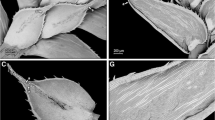Abstract
Observations on JapaneseSyringoderma from Rishiri Island, which had been previously identified asS. australe, were made based on newly collected fertile material. These results and comparisons with the type specimen ofSyringoderma abyssicola (=Chlanidophora abyssicola) revealed that the Rishiri Island plants should be identified asSyringoderma abyssicola. Syringoderma abyssicola from Rishiri Island formed unilocular sporangia among the paraphyses on the fan-shaped blades in winter. The first products (uni-spores) in the unilocular sporangia form flagella, and soon after form cell walls before release. Then these reduced gametophytes divide into tetrads and form swarmers, each of which contains a chloroplast with a stigma. These swarmers germinate into branched filaments, from which thicker erect filaments of apical growth tissue. At 5–10 C these erect filaments formed fan-shaped blades under long-day conditions, and unilocular sporangia under short-day conditions corresponding respectively to spring and winter at Rishiri Island. Accordingly, the seasonal growth pattern of the species is considered to be controlled by responses to photoregime and temperature.
Similar content being viewed by others
References
Delépine, R. 1968. Sur la morphologie et le mode de croissance de deux algues marines antarctiques. Soc. Bot. Fr. Mém115: 120–129.
Henry, E.C.. 1984. Syringodermatales ord. nov. andSyringoderma floridana sp. nov. (Phaeophyceae). Phycologia23: 419–426.
—. 1983. Studies on the life history ofSyringoderma phinneyi sp. nov. (Phaeophyceae). Phycologia22: 387–393.
Levring, T.. 1940. Die PhaeophyceengattungenChlanidophora, Distromium undSyringoderma. K. Fysiorg. Sällsk. Lund Förhandl.10: 217–227.
Matsunaga, K. andI. Yamada. 1974.Syringoderma australe Levring (Dictyotaceae), new to Japan, collected from Rishiri Island, northwestern Hokkaido. Bull. Jap. Soc. Phycol.22: 58–62.
Müller, D.G., W. Boland, F.-J. Marner andG. Gassmann. 1982. Viridiene, the sexual pheromone ofSyringoderma (Phaeophyceae). Naturwissenschaften69: 501–502.
Setchell, W.A. andN.L. Gardner. 1924. Phycological contributions, VII. Univ. Calif. Publ. Bot.13: 1–13.
— 1925. The marine algae of the Pacific coast of North America. III Melanophyceae. Univ. Calif. Publ. Bot.8: 383–898.
Spurr, A.R.. 1969. A low-viscosity epoxy resin-embedding medium for electron microscopy. J. Ultrartruct. Res.26: 31–43.
Tatewaki, M.. 1966. Formation of a crustaceous sporophyte with unilocular sporangia inScytosiphon lomentaria. Phycologia6: 62–66.
Walker, D.C. andE.C. Henry. 1978. Unusual reproductive structures inSyringoderma abyssicola (S. & G.) Levring. New Phytol.80: 193–197.
Wynne, M.J.. 1972. Culture studies of Pacific coast Phaeophyceae. Soc. Bot. Fr. Mém.1972: 129–144.
Author information
Authors and Affiliations
Additional information
Dedicated to the memory of the late Professor Muneao Kurogi.
Rights and permissions
About this article
Cite this article
Kawai, H., Yamada, I. The specific identity and the life history of JapaneseSyringoderma (Syringodermatales, phaeophyceae). Bot Mag Tokyo 103, 325–334 (1990). https://doi.org/10.1007/BF02488643
Received:
Accepted:
Issue Date:
DOI: https://doi.org/10.1007/BF02488643




